 |
|||||
|
Commerce in this material is especially dangerous because of the relative ease with which it can be made into a bomb. According to Manhattan Project physicist Luis Alvarez,
Not until the 1970s did the U.S. government begin to appreciate fully the proliferation dangers of such commerce. The Carter Administration realized that the HEU fuel could be diverted from research reactors and used directly by nations or terrorists to make nuclear weapons. Most research reactors are on university campuses and at research centers where security is lax and access to this material relatively unfettered. In 1978, the United States established the Reduced Enrichment for Research and Test Reactors (RERTR) Program to convert reactors at home and abroad from bomb-grade to low-enriched uranium (LEU) fuel and ensure the same reactor performance without the proliferation risks. Until late in the Reagan Administration, much progress had been made in this U.S.-led international effort to curtail global commerce in HEU. By the late 1980s, however, the program became endangered by neglect and lack of support in the Executive Branch. Nuclear Control Institute fought to restore funds that had been zeroed out and convinced Congress to keep the program going. For more
than a decade, NCI has played the leading role in maintaining and building
support in Congress and the Executive Branch for the reduced-enrichment program
and its objective of eliminating commerce in bomb-grade uranium. In 1990, we
intervened successfully before the U.S. Nuclear Regulatory Commission to block a
license to export bomb-grade fuel to a reactor in Europe that was capable of
converting to an alternate, non-weapons-grade fuel. Result: the fuel was never
sent, and Congress responded to the NCI initiative by enacting a law two years
later, the Schumer Amendment, which effectively cut off U.S. exports of
bomb-grade uranium. The law allows U.S. exports of bomb-grade fuel only on an
interim basis and only to
reactor operators who have agreed to convert their reactors as soon as possible to uranium that cannot be
used in weapons.
Nuclear Control Institute continues to work to eliminate all commerce in bomb-grade uranium by supporting efforts to convert research reactors in Russia, the former Soviet Republics and China to non-weapons-grade uranium. We also are leading an effort to win an international agreement among medical isotope producers to replace bomb-grade uranium targets, which are used to produce some isotopes in reactors, with targets made from low-enriched uranium. We also have been instrumental in winning support for an ongoing U.S. program to return spent fuel containing bomb-grade uranium to the United States from foreign research reactors. The spent fuel is to be blended down into a non-weapons-usable form and disposed of as waste.
|
|||||
 |
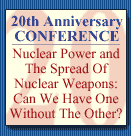 |
 |
 |
 |
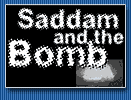 |
 |
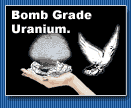 |
 |
 |
 |
 |
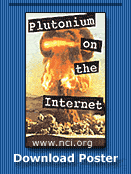 |
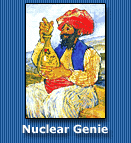 |
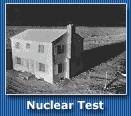 |

